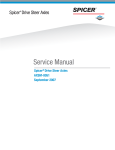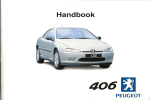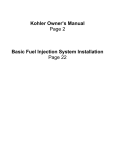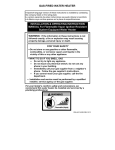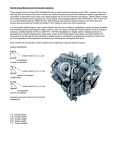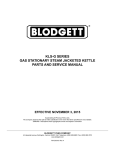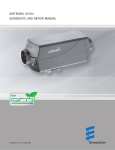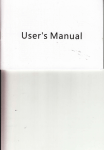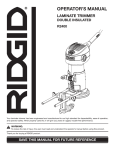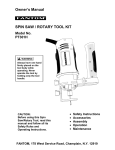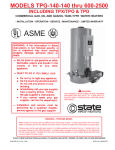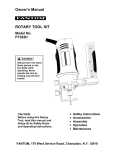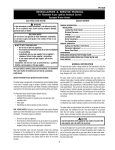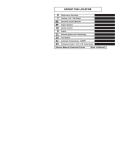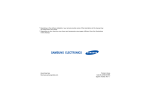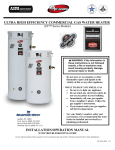Download Manuals - Lochinvar
Transcript
TNR-I&S-02 INSTALLATION & SERVICE MANUAL TEMPERATURE & PRESSURE RELIEF VALVE HIGH EFFICIENCY COMMERCIAL GAS WATER HEATER WARNING DANGER If the information in these instructions is not followed exactly, a fire or explosion may result causing property damage, personal injury or death. Use only vent terminals provided or factory authorized terminals for venting this water heater. This water heater is equipped with an adjustable thermostat to control water temperature. Hot water temperatures required for automatic dishwasher and laundry use can cause scald burns resulting in serious personal injury and/or death. The temperature at which injury occurs varies with the person’s age and the time of exposure. The slower response time of disabled persons increases the hazards to them. NEVER allow small children to use a hot water tap, or to draw their own bath water. NEVER leave a child or disabled person unattended in a bathtub or shower. Do not store or use gasoline or other flammable vapors and liquids in the vicinity of this or any other appliance. WHAT TO DO IF YOU SMELL GAS • Do not try to light any appliance. • Do not touch any electrical switch; do not use any telephone in your building. • Immediately call your gas supplier from a neighbor’s telephone. Follow the gas supplier’s instructions. • If you cannot reach your gas supplier, call the fire department. Installation and service must be performed by a qualified installer, service agency or the gas supplier. Failure to properly install the vent and air intake (if applicable) system could result in property damage, personal injury, or death. WARNING Keep clear of the combination temperature and pressure relief valve discharge line outlet. The discharge may be hot enough to cause scald injury. The water is under pressure and may splash. For protection against excessive temperatures and pressure, install temperature and pressure protective equipment required by local codes, but not less than a combination temperature and pressure relief valve certified by a nationally recognized testing laboratory that maintains periodic inspection of production of listed equipment or materials as meeting the requirements of the Standard for Relief Valves and Automatic Gas Shutoff Devices for Hot Water Supply Systems, ANSI Z21.22 and the Standard CAN1-4.4 Temperature, Pressure, Temperature and Pressure Relief Valves and Vacuum Relief Valves. The combination temperature and pressure relief valve must be marked with a maximum set pressure not to exceed the maximum working pressure of the water heater. The combination temperature and pressure relief valve rating must not be less than the hourly rating of the water heater. Install the combination temperature and pressure relief valve into the opening provided and marked for this purpose on the water heater. Note: Some models may already be equipped or supplied with an installed combination temperature and pressure relief valve. Verify that the combination temperature and pressure relief valve complies with local codes. If the combination temperature and pressure relief valve does not comply with local codes, replace it with one that does. Install a discharge line so that water discharged from the combination temperature and pressure relief valve will exit within six (6) inches (15.2 cm) above, or any distance below the structural floor and cannot contact any live electrical part. The discharge line is to be installed to allow for complete drainage of both the combination temperature and pressure relief valve and the discharge line. The discharge opening must not be subjected to blockage or freezing. DO NOT thread, plug or cap the discharge line. It is recommended that a minimum clearance of four (4) inches (10.2 cm) be provided on the side of the water heater for servicing and maintenance of the combination temperature and pressure relief valve. Do not place a valve between the combination temperature and pressure relief valve and the tank! TABLE OF CONTENTS GENERAL INFORMATION ...................................................... 1 INSTALLATION .................................................................. 2 Locating The Water Heater ........................................... 2 Minimum Clearances ..................................................... 2 Venting ........................................................................ 6 Combustion Air Supply ................................................. 19 Water Connections ....................................................... 4 Gas Connections .......................................................... 14 GENERAL OPERATION ........................................................... 15 MAINTENANCE ..................................................................... 17 TROUBLESHOOTING GUIDE .................................................. 20 GENERAL INFORMATION This gas-fired water heater is design certified by CSA International under the American National Standard, Z21.10.3 (as indicated on the rating plate) and CAN/CGA 4.3-M (as indicated on the rating plate) available from CSA Standards Association, 178 Rexdale Blvd., Etobicoke, Ontario, Canada M9W 1R3. This water heater must be installed in accordance with local codes. In the absence of local codes, it must be installed in compliance with the National Fuel Gas Code (ANSI Z223.1-Latest Edition), or in Canada CAN/CGA B149.1 Natural Gas Installation Code (Latest Edition) or CAN/CGA B149.2 Propane Installation Code (Latest Edition). DANGER DO NOT store or use gasoline or other flammable, combustible, or corrosive vapors and/or liquids in the vicinity of this or any other appliance. DO NOT install any damaged venting system components. If damage is evident then please contact the supplier where the water heater was purchased or the manufacturer listed on the rating plate for replacement parts. 1 TNR-I&S-02 This water heater must be located in an area where the general public does not have access to set temperatures. INSTALLATION INSTRUCTIONS WARNING This water heater must be located in an area where leakage of the tank, water line connections, or the combination temperature and pressure relief valve will not result in damage to the area adjacent to the water heater or to lower floors of the structure. When such locations cannot be avoided, a suitable drain pan must be installed under the water heater. The drain pan depth must be suitable for draining and collecting water, and have a minimum length and width of at least four (4) inches (10.0 cm) measured from the jacket of the water heater. The drain pan, as described above, can be purchased from your plumbing professional. The drain pan must be piped to an adequate drain. The piping must be at least ¾ inch (2.0 cm) in diameter and pitched for proper drainage. WARNING DO NOT ATTEMPT TO LIGHT ANY GAS APPLIANCE IF YOU ARE NOT CERTAIN OF THE FOLLOWING: • Liquefied petroleum gases/propane gas and natural gas have an odorant added by the gas supplier that aids in detection of the gas. • Most people recognize this odor as a “sulfur” or “rotten egg” smell. • Other conditions, such as “odorant fade” can cause the odorant to diminish in intensity, or “fade”, and not be as readily detectable. • If you have a diminished sense of smell, or are in any way unsure of the presence of gas, immediately contact your gas supplier from a telephone in another building. • Gas detectors are available. Contact your gas supplier or plumbing professional for more information. Liquefied petroleum gases/propane gas is heavier than air and will remain at floor level if there is a leak. Basements, crawl spaces, closets and areas below ground level will serve as pockets for accumulation of leaking gas. Before lighting, smell all around the appliance area for gas. Be sure to smell next to the floor. IF YOU SMELL GAS: • Do not try to light any appliance. • Do not touch any electric switch; do not use any telephone in your building. • Immediately call your gas supplier from a telephone in another building. Follow the gas supplier’s instructions. • If you cannot reach your gas supplier, call the fire department. DO NOT OPERATE THE APPLIANCE UNTIL THE LEAKAGE IS CORRECTED! Locating The Water Heater 1. LOCATE so that venting connections will be short and direct. 2. THIS WATER HEATER IS SUITABLE FOR INSTALLATION ON COMBUSTIBLE FLOOR. DO NOT install this water heater on carpeting. 3. FOR BASEMENT INSTALLATION, provide a solid level elevated base such as concrete. 4. Minimum clearance to combustible material is 0" for the Top, Sides and Rear of this water heater. However, it is recommended that at least 18" from the Top, 24" from the Front, and 4" for the Sides and Rear of the water heater be provided for servicing. Clearance for servicing may be reduced down to minimum clearance to combustible material, but service time and effort may be greatly increased. LOCATION KEEP APPLIANCE AREA CLEAR AND FREE OF COMBUSTIBLE MATERIALS, GASOLINE AND OTHER FLAMMABLE VAPORS AND LIQUIDS. Figure 1 Minimum Clearance To Combustible 2 TNR-I&S-02 • If horizontal ducts are used, each opening shall have a free area of not less than one square inch per 2000 Btu/hr of the total input of all appliances in the enclosure. AIR REQUIREMENTS 1. Do not obstruct the flow of combustion and ventilating air. 2. For safe operation, adequate air is needed for combustion and ventilation. Sooting may result in serious damage to the water heater and risk of fire or explosion. It can also create a risk of asphyxiation. Such a condition often will result in a yellow, luminous burner flame, causing carboning or sooting of the combustion chamber, burner and flue tubes. 3. If the water heater is installed as a direct vent (outside air piped directly to the water heater), then additional opening, other than the opening for the air intake, are not required. However, adequate ventilation air must be provided in all cases to prevent increased room temperature. MECHANICAL EXHAUSTING OF ROOM AIR 1. Where an exhaust fan is installed in the same room with this water heater and combustion air is drawn from inside the room, sufficient openings for air must be provided in the walls.UNDERSIZED OPENINGS WILL CAUSE AIR TO BE DRAWN INTO THE ROOM THROUGH THE WATER HEATER’S VENTING SYSTEM, CAUSING POOR COMBUSTION THAT MAY BE HAZARDOUS TO LIFE. SOOTING MAY RESULT IN SERIOUS DAMAGE TO THE WATER HEATER AND RISK OF FIRE OR EXPLOSION WHICH CAN ALSO CREATE A RISK OF ASPHYXIATION. Refer to local codes and /or National Fuel Gas Code for proper air opening sizing. CHEMICAL VAPOR CORROSION Corrosion of the flue ways and vent system will occur if air for combustion contains certain chemical vapors. Such corrosion may result in poor combustion and create a risk of asphyxiation. Spray can propellants, cleaning solvents, refrigerator and air conditioning refrigerants, swimming pool chemicals, calcium and sodium chloride, waxes and process chemicals are corrosive. Products of this sort should not be stored near the water heater or outside by the air intake (if applicable). TYPICAL INSTALLATION ILLUSTRATION UNCONFINED SPACE 1. In buildings of conventional frame, brick or stone construction, unconfined spaces may provide adequate air for combustion and ventilation. CAUTION If building cold water supply has a back-flow preventer, check valve or water meter with check valve provisions for thermal expansion of water in the hot water system must be provided. 2. If the unconfined space is within a building of tight construction (buildings using the following construction: weather stripping, heavy insulation, caulking, vapor barrier, etc.), air for combustion and ventilation must be obtained from outdoors. This may be accomplished by piping air directly to the water heater from outside or providing opening or ducts in the wall. The installation instructions for confined spaces in tightly constructed buildings must be followed to ensure adequate air supply. Figure 2 CONFINED SPACE 1. When drawing combustion air from inside a conventionally constructed building to a confined space, such a space shall be provided with two permanent openings. • The top opening is to be located within twelve (12) inches of the enclosure top and the bottom opening within twelve (12) inches of the enclosure bottom. • Each opening shall have a free area of at least one square inch per 1000 Btu/hr of the total input of all appliances in the enclosure, but not less than 100 square inches. 2. If the confined space is within a building of tight construction, air for combustion and ventilation must be obtained from outdoors. This may be accomplished by piping air directly to the water heater from outside or providing opening or ducts in the wall. When directly communicating with the outdoors through vertical ducts, two permanent openings, located in the above manner, shall be provided. • Each opening shall have a free area of not less than one square inch per 4000 Btu/hr of the total input of all appliances in the enclosure. 3 Typical Front Inlet Connection TNR-I&S-02 Figure 3 Typical Front Inlet Connect with Storage Tank Figure 6 Typical Four Water Heater Connection WATER CONNECTIONS WARNING Failure to install and maintain a new, listed temperature and pressure relief valve will release the manufacturer from any claim, which might result from excessive temperature and pressures. Hydrogen gas can be produced in an operating water heater that has not had water drawn from the tank for a long period of time (generally two weeks or more). HYDROGEN GAS IS EXTREMELY FLAMMABLE. To prevent the possibility of injury under these conditions, we recommend the hot water faucet to be open for several minutes at the kitchen sink before you use any electrical appliance, which is connected to the hot water system. If hydrogen is present, there will be an unusual sound such as air escaping through the pipes as hot water begins to flow. Do not smoke or have open flame near the faucet at the time it is open. Figure 4 Typical Two Water Heater Connection Keep clear of the combination temperature and pressure relief valve discharge line outlet. The discharge may be hot enough to cause scald injury. The water is under pressure and may splash. CAUTION If sweat fittings are to be used, DO NOT apply heat to the nipples in front or side of the water heater. Sweat the tubing to the adapter before fitting the adapter to the water connections. It is imperative that heat is not applied to the nipples containing a plastic liner. INSTRUCTIONS FOR CONNECTIONS Figure 5 Typical Three Water Heater Connection 1. BEFORE PROCEEDING WITH THE INSTALLATION, CLOSE THE MAIN WATER SUPPLY VALVE. After shutting off the main water supply, open a faucet to relieve the water line pressure to prevent any water from leaking out of the pipes while making the water connections to the water heater. The COLD water inlet and HOT water outlet are identified on the water heater. Make the proper plumbing connections between the water heater and the plumbing system to the house. Install a shut-off valve in the cold water supply line. 2. If this water heater is installed in a closed water supply system, such as the one having a back-flow preventer in the cold water supply, provisions must be made to control thermal expansion. DO NOT operate this water heater in a closed system without provisions for controlling thermal expansion. Warranties do not cover damages 4 TNR-I&S-02 from thermal expansion such as pressure bulges and/or deformities.Your water supplier or local plumbing inspector should be contacted on how to control this situation. Table 1 Approximate Time/Temperature Scald Chart APPROXIMATE TIME/TEMPERATURE RELATIONSHIPS IN SCALDS 120° F More than 5 minutes 125° F 1½ to 2 minutes 130° F About 30 seconds 135° F About 10 seconds 140° F Less than 5 seconds 145° F Less than 3 seconds 150° F About 1½ seconds 155° F About 1 second 3. After installation of the water lines, open the main water supply valve and fill the water heater. While the water heater is filling, open several hot water faucets to allow air to escape from the water system. When a steady stream of water flows through the faucets, close them and check all water connections for possible leaks. 4. Never operate the water heater without first being certain it is filled with water. SCALDING This water heater can deliver scalding temperature water at any faucet in the system. Be careful whenever using hot water to avoid scalding injury. Certain appliances such as dishwashers and automatic clothes washers may require increased temperature water. By setting the thermostat on this water heater to obtain the increased temperature water required by these appliances, you may create the potential for scald injury. To protect against injury, you should install ASSE approved mixing valve in the water system. This valve will reduce point of discharge temperature by mixing cold and hot water in branch supply lines. Such valves are available from the local plumbing supplier. Figure 7 ALTERNATE SPACE HEATING WATER CONNECTIONS DANGER Toxic chemical, such as those used for boiler treatment, shall not be introduced into potable water used for space heating. This water heater shall not be connected to an existing heating system or component(s) previously used with a non-potable water heating appliance. All piping components connected to this water heater for space heating applications must be suitable for use with potable water. Scald Warning WARNING When the system requires water for space heating at temperatures higher than required for other means, a tempering valve shall be installed to temper the water for those uses in order to reduce the scald hazard potential. Failure to properly pipe this water heater may result in improper operation and damage to the water heater or structure. Oxygen contamination of this water heater will cause corrosion of iron and steel components, and can lead to water heater failure. Connect the system supply and return piping to the water heater. Refer to Figure 8 and Figure 9 for installation examples. Maintain a minimum ½” clearance from hot water piping to combustible materials. Figure 8 Alternate Space Heating Connections The following chart details the relationship of water temperature and time with regard to scald injuy and may be used as a guide in determining the safest water temperature for your applications. 5 TNR-I&S-02 Figure 9 Typical Plumbing Schematic for Zoned Heating TuboCharger Water Heater VENTING CAUTION The vent shall terminate a minimum of 12 inches above expected snowfall level to prevent blockage of vent termination. The horizontal centerline of the exhaust vent terminal (if applicable) must not be located lower than the horizontal centerline of the air intake terminal if vented through the same wall. A service drain loop must be installed in the drain tubing to serve as a condensate trap to prevent flue gases from escaping in the room. DO NOT position air intake terminal above exhaust terminal. NEVER locate air intake terminal when exhaust gases can be introduced. WARNING The vent system must be properly installed. Failure to properly install the vent system could result in property damage, personal injury, or death. DO NOT install damaged venting system components. If damage is evident then please contact the supplier where the water heater was purchased or the manufacturer listed on the rating plate for replacement parts. NOTICE Use only the vent terminals provided or factory authorized terminals for venting this water heater. Before beginning installation of any vent pipe, read the vent pipe manufacturer’s installation instructions. Water heater must be protected from freezing downdrafts during shutdown periods. Provide protection of the building materials from degradation by flue gases from the exhaust vent terminal. The water heater requires its own separate venting system. Do not connect the exhaust vent into an existing vent pipe or chimney. All of the exhaust venting connections must be leak checked with a soap solution upon initial start up of the water heater. Any leaks must be repaired before continuing operation of the water heater. The venting instructions must be followed to avoid restricted combustion or recirculation of flue gases. Such conditions cause sooting or risks of fire and asphyxiation. Do not terminate the venting where noise from the exhaust or intake will be objectionable. This includes locations close to or across from windows and doors. Avoid anchoring the vent and intake pipes directly to framed walls, floors, or ceilings unless rubber isolation pipe hangers are used. This prevents any vibrations from being transmitted into the living spaces. This water heater can be installed as either a direct vent system or power vent (air from inside) system. If it is installed as a direct vent system, then the air intake and the exhaust vent are piped to the outside. If a power vented system is used, then air is drawn from inside and only the exhaust is piped to the outside. Determine which system is best for your application and install as described in the following sections. Do not exceed the venting distances or the number of elbows listed in this manual. Exceeding the maximum venting distances may cause the water heater to malfunction or cause an unsafe condition. DIRECT VENT INSTALLATION Venting may be run horizontally through an outside wall or vertically through a roof through using either 3 inch (7.6 cm) or 4 inch (10.2 cm) diameter PVC or CPVC pipe. This water heater is supplied with a 3 inch PVC screened intake and exhaust 90° elbow referred to as the exhaust vent terminal and the air intake terminal. DO NOT operate this water heater until the venting installation is complete and the piping completed. Failure to complete installation before operation can result in property damage, personal injury, or death. 6 TNR-I&S-02 EXCEPTIONS FOR INSTALLATIONS The vent terminal must not terminate: 1. Directly above a paved sidewalk or paved driveway which is located between two single-family dwellings and serves both dwellings; 2. Less than 7 feet (2.1 m) above a paved sidewalk or a paved driveway located on public property; 3. Within 6 feet (1.8 m) of a mechanical air supply inlet to any building; NOTICE If 4 inch PVC or CPVC pipe is used, then a 4 inch PVC or CPVC screened intake and exhaust 90° elbow is required. Direct Vent Terminal Location Plan the vent system layout so that proper clearances are maintained from plumbing and wiring. Before the vent is installed, determine the vent pipe termination location as shown below in Figure 10. Figure 10 Vent Terminal Location 4. Above a gas meter/regulator assembly within 3 feet (0.9 m) horizontally of the vertical centerline of the regulator; 5. Within 6 feet (1.8m) of any gas service regulator vent outlet; 6. Less than 1 foot (30.5 cm) above grade level; 7. Within 12 inches (30.5 cm) of a window or door, which can be opened in any building, any non-mechanical air, supply inlet to any building or the combustion air inlet of any other appliance; 8. Underneath a veranda, porch or deck, unless: • The veranda, porch or deck is fully open on a minimum of two sides beneath the floor and • The distance between the top of the vent termination and the underside of the veranda, porch or deck is greater than 1 foot (30.5 cm). Vent terminals must terminate at least 3 feet (0.9 m) above any forced air inlet located within 10 feet (3.1 m). This provision does not apply to: 1. The combustion air intake of a direct vent appliance or the circulating air inlet and flue gas discharge of listed outdoor appliances. 2. The exhaust vent terminal must be installed with at least 12 inches (30 cm) clearance from any air opening into a building. 3. The bottom of the exhaust vent and combustion air intake terminals must be located at least 12 inches (30 cm) above grade and above the anticipated snow level. 4. Must be installed at least 3 feet (0.9 m) from any gas meter, gas valve or other gas regulating equipment.Must be installed in a location where it will not be blocked by snow. 5. The exhaust vent and combustion air intake terminals must be installed so that the centerline distances are at least 18 inches (45.7cm) apart and the exhaust vent terminal elbow extends 6 inches (15.2 cm) past the combustion air intake terminal. The vent system must terminate so that proper clearances are maintained as cited in local codes or the latest edition of the National Fuel Gas Code, ANSI Z223.1.73.4e and 7.8a, b as follows: 1. Do not terminate the exhaust vent terminal over public area where condensate or vapor can cause nuisance or hazard. 2. For direct vent, the venting system shall terminate at least 1 foot below, 1 foot horizontally from or 1 foot above any door, window, or gravity air inlet into building. 7 TNR-I&S-02 3. For horizontal, the venting system shall terminate 4 foot below, 4 foot horizontally from or 1 foot above any door, window, or gravity air inlet into building. 4. The manufacturer also recommends the vent system terminations not be installed closer than 3 feet from an inside corner of an L shaped structure. 5. The vent termination shall not be mounted directly above or within 3 feet horizontally from an oil tank vent or gas meter to avoid potential freeze-up from condensation. 6. The vent shall terminate a minimum of 12 inches above expected snowfall level to prevent blockage of vent termination. 2. Use the proper PVC cement to secure the 90° exhaust vent and air intake terminals provided with the water heater to the plastic pipes. The distance between the back edge of the 90° exhaust vent terminal and the exterior wall (see Figure 11) must be 6 inches (12.7 cm) more for the exhaust vent terminal than the air intake terminal. Use the proper cement or sealant and assembly procedures to secure the vent connector joints between the terminal and the blower outlet. Provide support brackets for every 3 feet (.91 m) of horizontal vent. Figure 11. Typical Horizontal Direct Vent System Vent pipes serving power vented appliances are classified by building codes as “vent connectors”. Required clearances from combustible materials must be provided in accordance with information in this manual under LOCATION OF WATER HEATER and CLEARANCES, and with National Fuel Gas Code and local codes. NOTICE This unit can be vented using only PVC (Class 160, ASTM D-2241 Schedule 40, ASTM D-1785; or Cellular Core Schedule 40 DWV, ASTM F-891), Schedule 40 CPVC (ASTM F-411). The fittings, other than the TERMINATIONS should be equivalent to PVC-DWV fittings meeting ASTM F-2665. (Use CPVC fittings, ASTM F-438 for CPVC pipe.) If CPVC pipe and fittings are used, then the proper cement must be used for all joints, including joining the pipe to the Termination (PVC material). PVC materials should use ASTM –D2564 grade cement; CPVC materials should use ASTM F-493 grade cement. For water heaters in locations with high ambient temperatures (above 100° F) and/or insufficient dilution air, it is recommended that CPVC pipe and fittings (MUST USE SUPPLIED VENT TERMINAL) be used. Vertical Installation: Vertical venting system must be supported every 5 feet of vertical run and every 3 feet of horizontal run of vent pipe length. Stress levels in the pipe and fittings can be significantly increased by improper installation. If rigid pipe clamps are used to hold the pipe in place, or if the pipe cannot move freely through a wall penetration, the pipe may be directly stressed, or high thermal stresses may be formed when the pipe heats up and expands. Install accordingly to minimize such stresses. Horizontal Installation: In a horizontal application, it is important that condensate not be allowed to buildup in the exhaust vent pipe. To prevent this from happening the pipe should be installed with an slight upward slope so the condensate will run back toward the water heater. The vent system should be supported every 5 feet of vertical run and every 3 feet of horizontal run of vent pipe length. Follow the following procedure to vent through the roof: 1. Cut the necessary holes through the roof and ceiling. 2. Install the exhaust vent and air intake plastic pipes as shown in Figure 12. Make sure that the installation meets the local codes and/or The National Fuel Gas Code ANSI Z223.1 (Latest Edition) or CGA/CAN B149 Installation Code. Stress levels in the pipe and fittings can be significantly increased by improper installation. If rigid pipe clamps are used to hold the pipe in place, or if the pipe cannot move freely through a wall penetration, the pipe may be directly stressed, or high thermal stresses may be formed when the pipe heats up and expands. Install accordingly to minimize such stresses. Follow the following procedure to vent through the wall: 1. Cut two 3 1/2 in. (8.9 cm) diameter holes (for 3" (7.6 cm) diameter pipe) or 4 ½” (11.4 cm) diameter holes (for 4" (10.2 cm) diameter pipe) in the wall with the centerline hole distances at least 18" (45.72 cm) apart in the location where the exhaust vent and air intake terminals will exit the outside wall if vented on the same wall. 8 TNR-I&S-02 Table 2 Direct Vent Maximum Vent Length Figure 12 Typical Vertical Direct Vent System Installation Storage Rated Max Vent Length (ft) Capacity Input 3" PVC or CPVC (Gallons) (BTU/HR) 60 60 60 100 100 100 100 100 125,000 150,000 199,000 150,000 199,999 250,000 300,000 399,999 Max Vent Length (ft) 4" PVC or CPVC 120 100 80 120 100 80 60 50 170 150 130 170 150 130 110 100 Determining required vent length: 1. Determine the total length of straight vent pipe (in feet) required for both the intake and the exhaust. 2. Add 5 feet of venting for every 90° elbow. 3. Add 2 ½ feet of venting for every 45° elbow. 4. Total vent length can not exceed “Max Vent Length” in Table 2. 5. Air intake can not exceed exhaust by more than 30 feet in any venting situation. Through The Wall Venting with Low Ground Clearance: When venting cannot exit through the wall at a height greater than or equal to 12" (30.5 cm) (and above expected snow level) from the ground, then the installation must be modified as shown below (see Figure 13). NOTICE DO NOT include the 3" exhaust elbow or vent terminals in determining maximum vent length. Figure 13 Vent Terminal (Low Ground Clearance) POWER VENT INSTALLATION Power venting is where the indoor air is used and the exhaust is vented to the outside. Venting may be run horizontally through an outside wall or vertically through a roof through using either 3 inch (7.6 cm) or 4 inch (10.2 cm) diameter PVC or CPVC. This water heater is supplied with a screened intake and exhaust 90° elbow referred to as the exhaust vent terminal and the air intake terminal. Power Vent Terminal Location Refer to the “Direct Vent Terminal Location” (see page 7) section previously mentioned to determine the proper exhaust vent location. Plan the vent system layout so that proper clearances are maintained from plumbing and wiring. Vent pipes serving power vented appliances are classified by building codes as “vent connectors”. Required clearances from combustible materials must be provided in accordance with information in this manual under LOCATION OF WATER HEATER and CLEARANCES, and with National Fuel Gas Code and local codes. 9 TNR-I&S-02 Figure 14 Typical Horizontal Power Vent System NOTICE This unit can be vented using only PVC (Class 160, ASTM D-2241 Schedule 40, ASTM D-1785; or Cellular Core Schedule 40 DWV, ASTM F-891), Schedule 40 CPVC (ASTM F-411) pipe. The fittings, other than the TERMINATIONS should be equivalent to PVC-DWV fittings meeting ASTM F-2665. (Use CPVC fittings, ASTM F-438 for CPVC pipe.) If CPVC pipe and fittings is used, then the proper cement must be used for all joints, including joining the pipe to the Termination (PVC material). PVC materials should use ASTM –D2564 grade cement; CPVC materials should use ASTM F-493 grade cement. For water heaters in locations with high ambient temperatures (above 100° F) and/or insufficient dilution air, it is recommended that CPVC pipe and fittings (MUST USE SUPPLIED VENT TERMINAL) be used. Horizontal Installation: In a horizontal application, it is important that condensate not be allowed to buildup in the exhaust vent pipe. To prevent this from happening, the pipe should be installed with an slight upward slope. The vent system should be supported every 5 feet of vertical run and every 3 feet of horizontal run of vent pipe length. Stress levels in the pipe and fittings can be significantly increased by improper installation. If rigid pipe clamps are used to hold the pipe in place, or if the pipe cannot move freely through a wall penetration, the pipe may be directly stressed, or high thermal stresses may be formed when the pipe heats up and expands. Install accordingly to minimize such stresses. Follow the following procedure to vent through the wall: 1. Cut one 3 ½ in. (9.0 cm) diameter hole (for 3" (7.6 cm) diameter pipe) or 4 ½” (11.5 cm) diameter hole (for 4" (10.2 cm) diameter pipe). 2. Use the proper PVC cement or sealant to secure the 90° exhaust vent terminal provided with the water heater to the plastic pipes. The distance between the back edge of the 90° exhaust vent terminal and the exterior wall (see Figure 14) must be 6 inches (13.0 cm). Use the proper cement and assembly procedures to secure the vent connector joints between the terminal and the blower outlet. Provide support brackets for every 3 feet (1.0 m) of horizontal vent. 10 Vertical Installation: Vertical venting must be supported every 5 feet of vertical run and every 3 feet of horizontal run of vent pipe length. Stress levels in the pipe and fittings can be significantly increased by improper installation. If rigid pipe clamps are used to hold the pipe in place, or if the pipe cannot move freely through a wall penetration, the pipe may be directly stressed, or high thermal stresses may be formed when the pipe heats up and expands. Install accordingly to minimize such stresses. Follow the following procedure to vent through the roof: 1. Cut the necessary holes through the roof and ceiling. 2. Install the exhaust vent and air intake plastic pipes as shown in Figure 15. Make sure that the installation meets the local codes and/or The National Fuel Gas Code ANSI Z223.1 (Latest Edition) or CGA/CAN B149 Installation Code. Figure 15 Typical Vertical Power Vent System Installation TNR-I&S-02 Through The Wall Venting With Low Ground Clearance: When venting cannot exit through the wall at a height greater than or equal to 12" (30.5 cm) (and above expected snow level) from the ground, then the installation must be modified as shown below (see Figure 16). Refer to Tables 2 or 3 for maximum venting lengths using 3” (7.6 cm) or 4” (10.2 cm) diameter plastic pipe. COAXIAL VENTING INSTALLATION PROCEDURE WARNING Improper installation, adjustment, service, or maintenance can cause property damage, personal injury, or death. Consult a qualified installer, service agency, or the gas supplier for information or assistance. This kit must be used only for terminating this water heater. Do not use this termination kit for any other appliance. Using this kit on other appliances and/or water heaters can result in property damage, personal injury, or death. DO NOT operate this water heater until the installation and assembly of this kit is complete and the piping completed. Failure to complete installation before operation can result in property damage, personal injury, or death. Before beginning any installation, be sure the main electrical disconnect switch is in the OFF position. Electrical shock can cause personal injury or death. DO NOT operate this water heater with the rain cap removed or recirculation of combustion products may occur. Water may also collect inside larger combustion-air pipe and flow to the burner assembly. Failure to follow this warning could result in product damage, or improper operation, personal injury or death. Figure 16 Vent Terminal (Low Ground Clearance) CAUTION DO NOT use field-supplied couplings to extend pipes. Airflow restriction will occur and the water heater pressure switches may cause intermittent problems. Maximum Vent Length Determination Table 3 Direct Vent Maximum Vent Length Storage Capacity (Gallons) Rated Max Vent Length (ft) Input 3" PVC or CPVC (Btu/Hr) 60 60 60 100 100 100 100 100 125,000 150,000 199,999 150,000 199,999 250,000 300,000 399,999 120 100 80 120 100 80 60 50 Vertical Installation (Recommended) 1. Become familiar with coaxial vent kit. Max Vent Length (ft) 4" PVC or CPVC Figure 17 Dimensional Layout of Concentric Vent Kit 170 150 130 170 150 130 120 100 Figure 18 Concentric Vent Kit Part Identitication Determining required vent length: 1. Determine the total length of straight vent pipe (in feet) required. 2. Add 5 feet of venting for every 90° elbow. 3. Add 2 ½ feet of venting for every 45° elbow. 4. Total vent length can not exceed “Max. Vent ength” in Table 3. 2. Determine the best location for the termination kit. NOTICE Do not include the 3" exhaust elbow or vent terminals in determining maximum vent length. 3. Cut the recommended 5" diameter hole. 11 TNR-I&S-02 4. Partially assemble vent kit by performing the following: a. Cement concentric Y fitting to larger diameter pipe. (See Figure 18). b. Cement rain cap to smaller diameter pipe. (See Figure 19). 7. Install rain cap and small diameter pipe assembly in roof penetration assembly. Ensure small diameter pipe is cemented and bottomed in Y concentric fitting. 8. Cement heater combustion-air and vent pipes to concentric y fitting assembly (Figure 18). (See Figure 20) for proper pipe attachment. Figure 19 Rain Cap to Small Vent Pipe Ass’y 9. Operate heater through one cycle to ensure combustion-air and vent pipes are properly connected to concentric vent termination connections. Horizontal Installation: 1. Become familiar with coaxial vent kit. As shown in Figures 17 through 19. 2. Determine the best location for the termination kit. NOTICE 5. Install concentric Y fitting and pipe assembly through the structure’s hole and field-supplied roof boot/flashing. Do not allow insulation or other materials to accumulate inside pipe assembly when installing through the hole. 6. Secure assembly to roof structure as shown in (Figure 20) using fieldsupplied metal strapping or equivalent support material. NOTICE Position termination where vent vapors will not damage plants/shrubs or air conditioning equipment. Position termination where vent vapors will not be adversely effected by wind condition. Position termination where it will not be damaged or be subjected to foreign objects. Position termination where vapors will not be objectionable. 3. Cut the recommended 5" diameter hole. Ensure termination height is above the roof surface or anticipated snow level. Figure 20. If assembly is too short to meet height requirements, the 2 pipe supplied in the kit may be replaced by using the same diameter pipe. DO NOT extend the overall dimension by more than 60 in. (See Figure 17). 4. Partially assemble vent kit. a. Cement Y concentric fitting to larger diameter kit pipe. (See Figure 18). b. Cement rain cap to smaller diameter kit pipe. (See Figure 19). 5. Install concentric Y fitting and pipe assembly through the structure’s hole and field-supplied roof boot/flashing. Do not allow insulation or other materials to accumulate inside pipe assembly when installing through the hole. Figure 20 Concentric Vent Roof Top Attachment 6. Install rain cap and small diameter pipe assembly in concentric Y fitting and large pipe assembly. Ensure small diameter pipe is cemented and bottomed in concentric Y fitting. 7. Secure assembly to structure as shown in Figure 21. Ensure clearances as shown in Figure 21. 8. Cement heater combustion-air and vent pipes to concentric Y fitting termination assembly. (See Figure 21) for proper pipe attachment. 9. Operate heater through one cycle to ensure combustion-air and vent pipes are properly connected to concentric vent termination connections. 12 TNR-I&S-02 Figure 21 Concentric Vent Side Wall Attachment SELECTION OF MATERIALS VENT PIPE PREPARATION WARNING PRIMER – It is recommended that Tetrahydrofuran (THF) be used to prepare the surfaces of pipe and fittings for solvent welding. DO NOT use water, rags, gasoline or any other substitutes for cleaning PVC cellular core or CPVC surfaces. A chemical cleaner such as MEK may be used. DO NOT attempt to start this water heater until vent pipe solvent fumes completely clear from the room and inside the vent piping. INITIAL PREPARATION 1. Make sure the solvent cement you are planning to use is designed for the specific application you are attempting. 2. Know the physical and chemical characteristics and limitations of the PVC, PVC cellular core or CPVC piping materials that you are about to use. 3. Know the reputation of your pipe and cement manufacturer and their products. CEMENT – The cement should be a bodied cement of approximately 500 to 1600 centipoises viscosity containing 10-20% (by weight) virgin PVC material solvated with tetrahydrofuran (THF). Small quantities of dimethylformamide (DMF) may be included to act as a retarding agent to extend curing time. Select the proper cement; Schedule 40 cement should be used for Schedule 40 pipe. Never use all-purpose cements or commercial glues and adhesives to join PVC or CPVC pipe and fittings. SAFETY PRECAUTION: PRIMERS AND CEMENTS ARE EXTREMELY FLAMMABLE AND MUST NOT BE STORED OR USED NEAR HEAT OR OPEN FLAME. ALSO, USE ONLY IN A WELL VENTILATED AREA. 4. Know your own qualifications or those of your contractor. The solvent welding technique of joining PVC, PVC cellular core or CPVC pipe is a specialized skill just as any other pipe fitting technique. 5. Closely supervise the installation and inspect the finished job before start-up. 6. Contact the manufacturer, supplier, or competent consulting agency if you have any questions about the application or installation of PVC, PVC cellular core or CPVC pipe. 7. Take the time and effort to do a professional job. Shortcuts will only cause you problems and delays in start-up. The majority of failures in these systems are the result of shortcuts and/or improper joining techniques. 13 TNR-I&S-02 GAS CONNECTIONS Figure 22 Drip Leg WARNING Connect this water heater only to the type of gas as shown on the rating plate. Use clean black iron pipe or equivalent material approved by local codes and ordinances. (Dirt and scale from the pipe can enter the gas valve and cause it to malfunction). The inlet gas line must have at least a 3 inch (7.62 cm) drip leg (sediment trap) installed as close to the water heater’s gas valve as possible. A ground joint union must be installed in the gas supply line, as close to the water heater as possible, to permit servicing of the water heater. Compounds used on the threaded joints of the gas piping must be resistant to the action of liquefied petroleum gases/propane gas. DO NOT apply pipe dope to the gas valve inlet and make certain that no pipe dope has become lodged in the inlet screen of the gas valve. Extreme care must be taken to ensure no pipe dope enters the gas valve and to avoid excessive torque when tightening the gas supply line to the gas valve. Excessive torque may result in cracking of the gas valve housing. The suggested maximum torque is 31.5 foot lbs. (4.4 kg-m). The manufacturer of this water heater will not be liable for any damage or injury caused as a result of a cracked gas inlet as a result of excessive torque. The gas supply lines must meet all requirements of the National Fuel Gas Code ANSI Z223.1 (Latest Edition), or in Canada CAN/CGA B149.1 Natural Gas Installation Code (Latest Edition) or CAN/CGA B149.2 Propane Installation Code (Latest Edition). GAS METER SIZE – NATURAL GAS ONLY Be sure that the gas meter has sufficient capacity to supply the full rated gas input of the water heater as well as the requirements of all other gas fired equipment supplied by the meter. If the gas meter is too small, ask the gas company to install a larger meter having adequate capacity. This water heater and its gas connection must be leak tested before placing the water heater in operation. Check for gas leaks with a soap and water solution and a brush or a commercial leak detector fluid. NEVER USE A MATCH OR OPEN FLAME FOR TESTING! GAS PRESSURE REGULATION Main line gas pressure to the water heater should be between a maximum 14.0 inch W.C. and a minimum supply pressure as shown on the rating plate. The inlet gas pressure must not exceed the maximum value. The water heater is not intended for operation at higher than 14.0 inch water column (½ psi) supply gas pressure. Higher gas supply pressures require supplemental reducing service regulation. Exposure to higher gas supply pressure may cause damage to the gas controls which could result in fire or explosion. If overpressure has occurred such as through improper testing of gas lines or emergency malfunction of the supply system, the gas valve must be checked for safe operation. Make sure that the outside vents on the supply regulators and the safety vent valves are protected against blockage. These are parts of the gas supply system, not the water heater. BEFORE PLACING THE WATER HEATER IN OPERATION, CHECK FOR GAS LEAKAGE. USE SOAP AND WATER SOLUTION OR OTHER MATERIAL ACCEPTABLE FOR THE PURPOSE OF LOCATING GAS LEAKS. WARNING DO NOT USE MATCHES, CANDLES, FLAME OR OTHER SOURCES OF IGNITION FOR THIS PURPOSE. ELECTRICAL CONNECTIONS CAUTION WARNING The water heater and individual shutoff valve must be disconnected from the gas supply piping system during any pressure testing of the system at test pressures in excess of ½ psi (3.5 kPa). The water heater must be isolated from the gas supply piping system by closing its manual shutoff valve during any pressure testing of the gas supply system at test pressures equal to or less than ½ psi (3.5 kPa). The supply line must be capped when not connected to the water heater. If copper supply lines are used, they must be internally tinned and certified for gas service. Turn off or disconnect the electrical power supply to the water heater before servicing. Label all wires prior to disconnection when servicing controls. Wiring errors can cause improper and dangerous operation. Verify proper operation after servicing. All electrical wiring must be installed and grounded in accordance with local codes, or in the absence of local codes, the National Electrical Code, ANSI/NFPA 70 and/or CSA C22.2 Electrical Code. The water heater must be wired to a 120 VAC, 60 Hz, 15A power supply. The water heater should be connected to a GFI outlet and wired on a separate circuit and breaker. If a flexible line cord and plug is permitted by local code, then provide a three wire GFI grounding type receptacle within reach of the line cord provided on the control box. DO NOT plug the line cord into a receptacle that can have the power supply interrupted by a switch that is used to control lights or another appliance. 14 TNR-I&S-02 If wiring in conduit is required, remove the line cord and strain relief bushing in the control panel and install an electrical conduit connector. Connect the hot, neutral, and ground leads to the terminal block using quick connect terminals. Refer to the wiring diagram for the correct terminal locations for each wire lead. WARNING If the unit is exposed to the following, do not operate water heater until all corrective steps have been made by a factory authorized independent service contractor or qualified service professional. 1. Flooding to or above the level of the burner or controls 2. External firing 3. Damage 4. Firing without water 5. Sooting NEVER OPERATE THE WATER HEATER WITHOUT FIRST BEING CERTAIN IT IS FILLED WITH WATER AND A TEMPERATURE AND PRESSURE RELIEF VALVE IS INSTALLED IN THE RELIEF VALVE OPENING OF THE WATER HEATER. CAUTION Do not energize the electric circuit before the water heater tank is filled with water. This controller is Polarity sensitive. If the Hot and Neutral Supply voltage is reversed, the controller will not sense flame and the water heater will not operate. Verify polarity before connecting the water heater. WIRING DIAGRAM AND SCHEMATIC Figure 23 Wiring Diagram and Schematic GENERAL INSTRUCTIONS OPERATING INSTRUCTIONS WARNING Water heaters are heat-producing appliances. To avoid damage or injury there must be no materials stored against the water heater or direct vent system, and proper care must be taken to avoid unnecessary contact (especially by children) with the water heater and direct vent system. UNDER NO CIRCUMSTANCES SHOULD FLAMMABLE MATERIALS, SUCH AS GASOLINE OR PAINT THINNER BE USED OR STORED IN THE VICINITY OF THIS WATER HEATER OR IN ANY LOCATION FROM WHICH FUMES COULD REACH THE WATER HEATER. Installation or service of this water heater requires ability equivalent to that of a licensed tradesman in the field involved. Plumbing, air supply, venting, gas supply and electrical work are required. Light the unit in accordance with the operating instructions label attached to the water heater. Under no circumstances should the input rate exceed the input rate shown on the water heater rating plate. Over firing could result in damage or sooting of the water heater. TO FILL THE WATER HEATER 1. Close the water heater drain valve by turning the knob or valve stem clockwise. If alternative water connections are provided but not used, make certain they are plugged (i.e. rear connections). 2. Open the cold water supply shut-off valve. 3. Open several hot water faucets to allow air to escape from the system. 4. When a steady stream of water flows from the faucets, the water heater is filled. Close the faucets and check for water leaks at the water heater drain valve, combination temperature and pressure relief valve and the hot and cold water connections. SEQUENCE OF OPERATION 1. A call for heat from thermostat 2. Blower ON 3. Pressure switch proves blower operation 4. Blower pre-purge 5. Igniter warm-up 15 6. 7. 8. 9. 10. Main burner ON Flame signal confirmed Thermostat satisfied Main burner OFF Blower post-purge TNR-I&S-02 LIGHTING INSTRUCTIONS Figure 24 Lighting Instruction Label 16 TNR-I&S-02 TEMPERATURE ADJUSTMENT The temperature selector knob of the thermostat has been adjusted to 120° F when shipped from the factory. Figure 25 Sight Glass Location NOTICE The lower the temperature setting, the greater the energy efficiency, both to heat the water and to maintain the storage temperature during standby periods. Lower water temperatures also extend tank life. Remember, no water heating system will provide exact temperatures at all times. Allow a few days of operation at this setting to determine the correct temperature setting consistent with the requirements for the installation. CAUTION This water heater, when set at a lower temperature setting is not capable of producing hot water of sufficient temperature for sanitizing purposes. During the winter season or any cold period, you may desire a higher temperature setting to adjust for the colder incoming water. This adjustment, however, may cause additional condensation to form on the colder tank surface. This does not mean the tank is leaking. During summer months, the warmer incoming water temperatures will benefit the performance of your water heater and reduce the amount of condensation developed. Condensation does not mean your tank is leaking. Most of reported tank leaks on installation are proven to be condensation. To avoid unnecessary inconvenience and expense, make sure the tank is leaking before calling an independent servicing contractor or qualified service professional. DANGER Hotter water increases the risk of scald injury. Scalding may occur within 5 seconds at a temperature setting of 135°F (57°C). To protect against hot water injury, install an anti-scald tempering valve in the water system. This valve will reduce point of discharge temperature by mixing cold and hot water in branch water lines. A licensed plumbing professional or local plumbing authority should be consulted. This water heater is equipped with an energy cut out device to prevent overheating. Should overheating occur or the gas supply fail to shut off, turn off the manual gas control valve to the appliance and call a qualified service agency. MAINTENANCE DANGER DO NOT ATTEMPT TO REPAIR GAS VALVE. DO NOT ATTEMPT TO REPAIR IGNITION MODULE. DO NOT ATTEMPT TO REPAIR VENTURI. DO NOT ATTEMPT TO REPAIR THERMOSTAT BOARD. DO NOT ATTEMPT TO REPAIR TRANSFORMER. DO NOT ATTEMPT TO REPAIR PRESSURE SWITCH. GENERAL KEEP APPLIANCE AREA CLEAR AND FREE FROM COMBUSTIBLE MATERIALS, GASOLINE AND OTHER FLAMMABLE VAPORS AND LIQUIDS. Water heater maintenance includes periodic tank flushing and cleaning, and removal of lime scale. The unit should be inspected and adjusted to maintain proper combustion. Refer to Table 4, “Suggested Maintenance Schedule”. A periodic inspection of the venting system should be made. If the water heater is to remain idle for 30 days or more or is subjected to freezing temperatures while shut off, the water heater and piping should be fully drained and the drain valve should be left fully open. Refer to the “General Operation” section of this Installation and Operating Instructions Manual for the procedure on draining the water heater. BURNER FLAME CHECK At the time of installation and at monthly intervals, a visual check of the burner flames should be made to determine if they are burning properly. The main burner may be seen through the sight glass window on the front of the combustion insert mounting bracket (Figure 25). The burner flames should be a blue flame near the burner surface in a uniform flame pattern. Occasional yellow or white streaks are normal. 17 MAINTENANCE SCHEDULE Following are the instructions for performing some of the recommended maintenance. Unit inspection and adjustment should be performed by a competent technician. TNR-I&S-02 Table 4 Suggested Maintenance Schedule COMPONENT OPERATION INTERVAL REQUIRED Tank Sediment Removal Monthly Flushing Anode Rods Inspect Semi-Annually Replace as Required Relief Valve Check Operation Semi-Annually Proper Operation Blower Clean Inlet Screen As Required Soft Brush Vent & Air Intake System Inspect Every 3 Months Joints should be sealed Ignition System Inspect Annually Clean of dust and dirt Vent Terminal Free of Shrubs & Debris Monthly Remove object that caused restriction Combustion System Inspect Monthly Confirm S-OP Condensate Line Inspect Monthly Remove restriction FLUSHING WATER HEATER 1. Turn OFF the water heater electrical disconnect switch. 2. Open the drain valve and allow water to flow until it runs clean. 3. Close the drain valve when finished flushing. 4. Turn ON the water heater electrical disconnect switch. the water. This is the lime scale which forms in pipes, water heaters and on cooking utensils. DRAINING WATER HEATER The water heater must be drained if it is to be shut down and exposed to freezing temperatures. Maintenance and service procedures may also require draining the water heater. 1. Turn off the water heater electrical disconnect switch. 2. Connect a hose to the drain valve. 3. Locate hose’s discharge in an area where hot water will not cause any damage or injury. 4. Close the cold water inlet valve to water heater. 5. Open a nearby hot water faucet to vent the system. 6. Open the heater drain valve. 7. If the water heater is being drained for an extended shutdown, it is suggested the drain valve be left open during this period. The usage of water softening equipment greatly reduces the hardness of the water. However, this equipment does not always remove all of the hardness (lime). For this reason it is recommended that a regular schedule of deliming be maintained. Lime accumulation not only reduces the life of the equipment but also reduces efficiency of the water heater and increases fuel consumption. FILLING WATER HEATER 1. Close the water heater drain valve by turning the knob or valve stem clockwise. If alternative water connections are provided but not used, make certain they are plugged (i.e. rear connections). 2. Open the cold water supply shut-off valve. 3. Open several hot water faucets to allow air to escape from the system. 4. When a steady stream of water flows from the faucets, the water heater is filled. Close the faucets and check for water leaks at the water heater drain valve, combination temperature and pressure relief valve and the hot and cold water connections. SEDIMENT AND LIME SCALE REMOVAL Waterborne impurities consist of the particles of soil and sand which settle out and form a layer of sediment on the bottom of the tank. The amount of calcium carbonate (lime) released from water is in direct proportion to water temperature and usage. The higher the water temperature or water usage, the more lime deposits are dropped out of 18 The depth of the buildup should be measured periodically. Water heaters will have about 3 inches of lime buildup when the level of lime has reached the bottom of the cleanout opening or about 1 inch of lime buildup if it has reached the drain valve opening. A schedule for deliming should be set up, based on the amount of time it would take for a ½ inch buildup of lime. Example1: Initial inspection shows ½ an inch of lime accumulation. Therefore, the water heater can be delimed once a year. To remove sediment and lime scale: 1. Drain the heater. Refer to DRAINING THE WATER instructions in this section. 2. Remove outer cover plate from lower side of water heater jacket. 3. Remove cover and gasket from cleanout opening. 4. Remove lime, scale or sediment using care not to damage the glass-lining. 5. Inspect cleanout plate gasket: Replace gasket if necessary (Contact local distributor for correct part number). 6. Install gasket and cleanout plate. Be sure to draw plate up tight by tightening screws securely. 7. Close the drain valve. Open a hot water fixture to allow air to escape. Open the cold water supply to water heater and allow the tank to fill. Follow the lighting instructions. 8. Check for water leakage. 9. Install outer jacket cover plate. TNR-I&S-02 ANODE INSPECTION AND REPLACEMENT This water heater is equipped with multiple sacrificial anodes. Anodes protect the glass-lined tank from corrosion by sacrificing themselves through electrolysis. When the anode material is consumed, there is no more protection and corrosion of the tank accelerates. Inspection of the anode every 6 months allows you to identify the rate of anode degradation. The anode should be replaced when its diameter is 3/8 of an inch, or annually which ever is first. Aggressive, very hot and softened water causes rapid consumption of the anode requiring frequent inspections. The replacement anodes rods are available from your local distributor. To inspect or replace an anode: The anodes on this water heater are easily accessible from the top of the water heater making replacement simple and quick. Use the following procedure to remove and inspect the anodes. 1. Drain the heater. Refer to DRAINING THE WATER HEATER instructions in this section. 2. Flush the heater. Refer to FLUSHING THE WATER HEATER instructions in this section. 3. Remove the combustion surround top by unlatching. 4. Remove the second pass access cover. (If equipped) 5. Remove the second pass insulation. 6. Remove the second pass collector cover. 7. Remove the anode using a socket of the appropriate size. Sometimes a breaker bar will need to be used. DO NOT use an impact wrench. 8. Inspect and replace the anode as required. Use pipe tape or sealant when reinstalling the anode. 9. Close the drain valve. Open a hot water fixture to allow air to escape. Open the cold water supply to water heater and allow the tank to fill. Follow the lighting instructions. 10. Check your anode and drain valve for leaks. 11. Replace second pass collector cover. Make sure to clean off any sealant and reseal before fastening. 12. Replace second pass insulation. 13. Replace second pass access cover. 14. Replace combustion surround top and latch it securely in place. DRAIN VALVE AND TANK ACCESS PANEL The water heaters are equipped with a ¾ inch drain valve. An access panel covers the cleanout opening in the tank which is sealed by a gasket and cover. RELIEF VALVE At least twice a year, the temperature and pressure relief valve should be checked to ensure that it is in operating condition. To check the relief valve, lift the lever at the end of the valve several times. The valve should seat properly and operate freely. explosion. In areas with poor water conditions, it may be necessary to inspect the T&P valve more often than the recommended maintenance schedule. CAUTION Before manually operating the valve, make sure that a drain line has been attached to the valve to direct the discharge to an open drain. Failure to take this precaution could mean contact with extremely hot water passing out the valve during this checking operation. If the temperature and pressure relief valve on the water heater discharges periodically or continuously, it may be due to thermal expansion of water in a closed water supply system, or, it may be due to a faulty relief valve. Thermal expansion is the normal response of water when it is heated. In a closed system, thermal expansion will cause the system pressure to build until the relief valve actuation pressure is equaled. Then, the relief valve will open, allowing some water to escape, slightly lowering the pressure. Contact your water supplier or local plumbing inspector on how to control this situation. WARNING Above all, do not plug the temperature and pressure relief valve. This is not a solution and can create a hazardous situation. VENT AND AIR INTAKE SYSTEM Examine the vent and air intake system every 3 months. Points of inspection are as follows: 1. Check for obstructions and/or deterioration of vent piping and vent terminal. Replace immediately where needed. 2. Vent pipe and vent hood screen should be cleaned of any foreign material. The screen is located inside the vent hood outlet and is accessible from the outside of the hood. DO NOT reach inside the vent hood when the water heater is in operation. 3. Check all vent system connections for leakage and reseal as required. COMBUSTION SYSTEM INSPECTION Inspect the operation of the combustion system monthly. Use the following procedure to inspect the combustion system. 1. Turn off the main power switch of the water heater. 2. Adjust the thermostat to the Min. setting. 3. Remove the top of the combustion surround by unlatching it. 4. While observing the ignition module, turn on the main power switch. 5. Adjust thermostat to the Max. setting. 6. Watch the LED’s light as the controller goes through the S-OP as previously described. 7. Upon ignition, observe the main burner flame. 8. Readjust thermostat to previous setting. 9. Replace combustion surround top and latch it securely in place. If water does not flow, remove and inspect for obstructions or corrosion. Replace with a new valve of the recommended size as necessary. A thorough inspection of the valve should be performed at least every three years by removing the temperature and relief valve from the tank. Do not attempt to repair the valve, as this could result in improper operation and a tank 19 TNR-I&S-02 TROUBLESHOOTING GUIDE Main power light is not lit. Make sure that water heater is plugged in. When the switch is on, is there 120VAC between L1 and N on the terminal block? If not, then check for loose wire connections on the “Power Switch Wire Harness.” If connections are ok, then replace the switch. If there is voltage between L1 and N then the light on the switch is burnt out. Replace switch. Thermostat does not call for heat. Make sure that the temperature of the tank is cool. If the thermostat does not call for heat, then check the PRIMARY voltage across the “Transformer”. If there is voltage across the PRIMARY, then check the voltage across the SECONDARY leads of the “Transformer”. Install a jumper wire from N.O. terminal to the COM terminal on the “Thermostat PC Board.” If the thermostat calls for heat after installing a jumper wire then check the “Thermostat Sensor Probe” leads for proper resistance with an OHM meter (See appendix A). If sensor reading are not correct, replace “Thermostat Sensor Probe.” If the sensor readings are correct, then check “Potentiometer” for the proper resistance. If the readings are correct, then replace the “Thermostat PC Board”, otherwise replace the “Potentiometer.” Ignition module “Power” LED is not lit. Check for 120 VAC at the ignition module on “120 VAC IN.” If there is voltage, then replace the ignition module. If there is not any voltage, check the voltage across the transformer as previously described. Blower does not energize. Is the “Vacuum Switch” (air intake switch) N.C.? If no, then check the hose and see if it is filled with condensate. If the hose is not filled with condensate, then replace vacuum switch. If filled, empty hose. Is the “Pressure Switch” (exhaust pressure switch) N.O.? If no, then check the hose and see if it is filled with condensate. If the hose is not filled with condensate, then replace pressure switch. If filled empty hose. Is the “Collector Limit Switch” N.C.? If no, then reset switch. If this switch trips more than 3 times, call service. If all items above are ok, then replace the blower. Ignitor does not glow. Is there voltage to the “Hot Surface Ignitor”? Check for 120VAC to the ignitor from the ignition module. Is there continuity across the “Hot Surface Ignitor?” If no, then replace hot surface ignitor. If yes, then replace the ignition module. Main valve does not turn on. Put your hand on the gas valve. When the “Valve” LED lights on the ignition module, can you feel it energize? If not, then check the voltages at the ignition module across pins 2 and 7 on the plug “CONTROL”. If there is 24 VAC across these pins, then check to see if the “Rectifier Harness” is secure. If it is secure, then replace the “Gas Valve”. If you can feel the gas valve energize, check the main gas supply is not in the off position. Burner Flame keeps going out. Is there minimum gas supplied to water heater as stated on the rating plate? If not, then increase the supply pressure to the water heater. Measure the microAmps through the flame sensor using a multimeter. Is there at least 4 microAmps? If not, then replace the “Flame Sensor” or flame sensor wire. Thermostat does not satisfy. Is the tank temperature above the temperature set point? Does the T&P relief valve leak? If yes, then replace “Thermostat PC Board.” Blower did not post purge Check “Vacuum Switch” (air intake switch) as previously mentioned. Check “Pressure Switch” (exhaust pressure switch) as previously mentioned. Check “Collector Limit Switch” as previously mentioned. If above switches are all ok, then replace “Ignition Module.” 20 9/07 Printed in USA





















